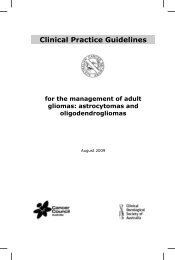Clinical Practice Guidelines for the management of locally advanced ...
Clinical Practice Guidelines for the management of locally advanced ...
Clinical Practice Guidelines for the management of locally advanced ...
Create successful ePaper yourself
Turn your PDF publications into a flip-book with our unique Google optimized e-Paper software.
with bone pain at study entry. At nine weeks <strong>the</strong> mean decrease in worst pain score on a 0–10 pain<br />
scale was 0.86 in <strong>the</strong> pamidronate arm and 0.69 in <strong>the</strong> placebo group (p=0.58). No significant<br />
difference was seen in <strong>the</strong> use <strong>of</strong> radiation <strong>for</strong> bone pain relief (p=0.88). However a pre-planned<br />
subgroup analysis <strong>of</strong> men with stable or falling analgesia showed at nine weeks (n=121) a 2.13 unit<br />
decrease in mean worst pain score on a 0–10 scale in <strong>the</strong> pamidronate group, which was significantly<br />
(p=0.008) larger than <strong>the</strong> 0.79 unit decrease in <strong>the</strong> placebo group. Retrospective subgroup analysis <strong>for</strong><br />
men with moderate ra<strong>the</strong>r than mild baseline pain was reported to show a significant reduction in pain<br />
(p=0.004) at nine weeks.<br />
Ernst et al 2003 35 using a randomised double blind design (n=227) compared clodronate (1500 mg iv<br />
every three weeks) combined with mitoxantrone and prednisone with placebo and mitroxantrone and<br />
prednisone. Similar levels <strong>of</strong> pain control were noted in both arms; 43% experiencing pain<br />
improvement in <strong>the</strong> clodronate arm and 38% experiencing pain improvement in <strong>the</strong> placebo group<br />
(p=0.52). In this study analgesia was considered in determining <strong>the</strong> pain response. Similar proportions<br />
<strong>of</strong> men required local radio<strong>the</strong>rapy with over 12 months follow-up; 16% <strong>of</strong> men in <strong>the</strong> clodronate arm<br />
and 14% <strong>of</strong> <strong>the</strong> men in <strong>the</strong> placebo arm (p=0.85). However, in a subgroup analysis <strong>of</strong> men with<br />
moderate ra<strong>the</strong>r than mild baseline pain (n=49), 58% <strong>of</strong> men receiving clodronate treatment<br />
experienced pain palliation whereas only 26% <strong>of</strong> men receiving placebo experienced pain palliation<br />
(odds ratio=4.6, 95% CI=1.3 to 15.5, p=0.04).<br />
For completeness and to appreciate <strong>the</strong> limitations <strong>of</strong> <strong>the</strong> remaining studies, a brief outline follows.<br />
Smith 1989 37 examined <strong>the</strong> effect <strong>of</strong> sodium etidronate on <strong>the</strong> control <strong>of</strong> bone pain in a small (n=28)<br />
double-blind RCT. Men received ei<strong>the</strong>r sodium etidronate (iv) 7.5 mg/kg/day <strong>for</strong> three days <strong>the</strong>n<br />
orally 2x200mg/day <strong>for</strong> one month, or placebo. No significant differences were observed between <strong>the</strong><br />
two groups (p=1.00).<br />
Adami and Mian 1989 38 randomised 13 men with radiographic evidence <strong>of</strong> bone metastases to<br />
treatment with ei<strong>the</strong>r 300mg <strong>of</strong> sodium clodronate (iv) daily or placebo <strong>for</strong> 14 days. It was reported<br />
that pain scores measured using a visual analogue scale and analgesic consumption fell in <strong>the</strong> treated<br />
group, but <strong>the</strong> statistical significance <strong>of</strong> <strong>the</strong> difference compared with <strong>the</strong> placebo group was not<br />
reported. In a multi-centre double-blind RCT without any documented chemo<strong>the</strong>rapy, Strang et al<br />
1997 39 treated 55 men with ei<strong>the</strong>r sodium clodronate 300mg (iv) <strong>for</strong> three days followed by oral<br />
sodium clodronate at a dose <strong>of</strong> 3200mg daily or placebo <strong>for</strong> four weeks. They did not find a<br />
significant improvement in pain scores between groups at 32 days follow up, however <strong>the</strong>ir data<br />
suggested that patients with higher initial pain scores (n=20) may have a better response than those<br />
with lower scores. This trial was terminated prematurely because <strong>of</strong> recruitment difficulties and as a<br />
result numbers may not have been sufficient to show any statistically significant differences in men<br />
with high pain scores.<br />
Elomaa et al 1992 33 and Kylmala et al 1993 40 reported a randomised trial <strong>of</strong> sodium clodronate<br />
3.2g/day <strong>for</strong> one month followed by 1.6g/day <strong>for</strong> a fur<strong>the</strong>r five months. At one month <strong>the</strong>re was a<br />
reduction in pain from baseline in both <strong>the</strong> control and <strong>the</strong> clodronate arms. Although <strong>the</strong> reduction<br />
was greater in <strong>the</strong> treated group, with 28% <strong>of</strong> men no longer experiencing pain compared with 15% <strong>of</strong><br />
men in <strong>the</strong> control arm, <strong>the</strong> difference was not statistically significant (p=0.26). The probable<br />
explanation <strong>for</strong> this finding (ie pain relief without clodronate in <strong>the</strong> control group) was that both<br />
groups were started on estramustine phosphate 2x280mg per day at <strong>the</strong> same time as <strong>the</strong> clodronate.<br />
The symptomatic improvement in <strong>the</strong> control group was almost certainly due to <strong>the</strong> effect <strong>of</strong> <strong>the</strong><br />
extramustine, thus rendering it difficult to determine <strong>the</strong> true effect <strong>of</strong> clodronate.<br />
Kylmala et al 1997 34 reported <strong>the</strong> results <strong>of</strong> a similar double-blind placebo controlled trial. Fifty-seven<br />
men, most <strong>of</strong> whom had painful bone metastases, began estramustine <strong>the</strong>rapy and were randomised to<br />
ei<strong>the</strong>r clodronate (iv) 300mg a day <strong>for</strong> five days and <strong>the</strong>n oral clodronate 1.6g/day <strong>for</strong> 12 months, or<br />
placebo. Again, no significant difference was found between <strong>the</strong> groups, with mean pain scores in <strong>the</strong><br />
treatment group not significantly improved from those in <strong>the</strong> control group over <strong>the</strong> 12 months.<br />
81<br />
Castration-resistant prostate cancer



